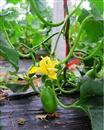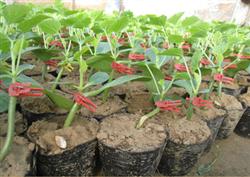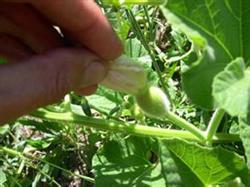Production and control of deformed fruit of muskmelon

In melon production, uncomfortable environmental conditions, water and fertilizer and other improper management will lead to abnormal fruit development and abnormal fruit. The horizontal diameter of flat fruit is obviously larger than that of vertical diameter, which is prominent in spherical or subspherical varieties. The causes are as follows: the longitudinal development of young fruit is not fully developed in the early stage of young fruit production; the vegetative growth of the plant is weak, the leaf shape is small, the leaf area is insufficient, and the fruit growth is blocked because of insufficient assimilation nutrients; the fruit node is low, and the fruit development is at a low temperature; it is also easy to form flat fruit under high temperature in summer; it is easier to form flat fruit by controlling water in order to promote fruit setting and fertilizing a large amount of water in the later stage to promote fruit expansion. Control methods: ① adjusted the cultivation season and improved the light and temperature conditions of protected cultivation to make the fruit development at the normal temperature, the suitable temperature in the early stage was 23 Murray 24 ℃, and the ideal temperature in the fruit expansion period was 27 Murray 30 ℃. ② controls the fruiting part so that it can bear fruit in the suitable part so as to ensure adequate assimilation nutrition during fruit development. The poor growth potential of ③ plants can postpone the fruiting, and if necessary, remove the young fruits from the nodes to promote the vegetative growth of the plants, and then promote the fruiting. ④ flowering and fruit setting period should pay attention to water supply, water control should not be too ruthless. In contrast to the flat fruit, the longitudinal diameter of the fruit is obviously larger than the transverse diameter, and it is prominent in the spherical and oval varieties, which has a great influence on the appearance. most fruits have thinner pulp and lower sugar content. The causes are as follows: high node fruiting, large functional leaves, fast growth at the initial stage and full development of longitudinal diameter, but in the later stage of fruit expansion, due to premature senescence of plants or occurrence of diseases and insect pests in leaves, functional leaf area decreases sharply and poor nutrient supply leads to poor development of transverse diameter and formation of long melons. Prevention and treatment: ① should reduce the position of fruit setting node properly. ② strengthens the management of fertilizer and water in the later stage of fruit setting to prevent plant premature senescence. ③ strengthens the control of leaf diseases and insect pests and maintains the function of leaves. ④ pruning control should not be too strict, the whole plant always retain 1 Murray two growth points, promote its continuous formation of new leaves, to prevent premature senescence of leaves. There is little difference in the size of fruits with normal fruit development, but some individual fruits often occur in actual production, and fruits weighing less than 200 grams are called small fruits. Causes: plant growth is too weak; early fruit at low node position, due to lack of functional leaves, fruit can not get sufficient assimilation nutrition and can not develop normally; laissez-faire growth, plant fruit number is too many, nutrients are dispersed, fruit shape becomes small; plant vegetative growth is too prosperous, can not set fruit in time, and then the fruit at high node position will become small fruit due to poor nutrition. Prevention and treatment methods: strengthen the management of fertilizer cultivation and promote vegetative growth in the early stage of ①. ② should prune reasonably and control the fruiting position according to the characteristics of varieties and cultivation methods. Generally, each plant leaves 1 MULTHI 2 fruits. When the growth potential of ③ plant is weak, the young fruit can be removed, the vegetative growth can be promoted and the fruiting can be delayed. ④ should use artificial pollination to promote fruit setting for plants with vigorous growth. At 6: 00-8: 00 in the morning, the male flowers of the same day are used to order the female flowers of the same day, and they are gently touched twice for artificial pollination. The crack forms a large and deep crack on the surface of the fruit, which is difficult to heal and seriously affects the quality. Cause: fruit cracking occurs violently after the fruit surface hardens, and the occurrence of fruit cracking is affected by the degree of pericarp hardening and water content. when the sun is sunny and the sun is strong, the epidermis will harden and too much water will be watered in cloudy and rainy days. the plant will cause fruit cracking after absorbing water. Cultivated in protected areas, when ventilated, the epidermis is easy to harden when it encounters cold air, causing cracking. Control method: ① first uses the variety with less fruit cracking before harvest. ② irrigation should be reasonable, pay attention to irrigation period and irrigation amount, less irrigation in the expansion period, rainy areas in the later stage of fruit growth should strengthen drainage, avoid stagnant water in the field, and control the water supply after the fruit expansion period. ③ protects the leaves near the fruit from direct exposure to sunlight. Can cover grass and leaves on the fruit to avoid early hardening of the pericarp.
- Prev

Management of melon fruiting period
Continuous cropping is the most avoided in muskmelon cultivation. In order to ensure the successful planting of muskmelon year after year, grafted seedlings are used to produce muskmelon, and the grafting method is mostly used. Muskmelon growers in Luannan County, Hebei Province improved the connection method and achieved good results. Choose pumpkin with strong disease resistance and cold resistance as rootstock with high yield.
- Next

Fertilizer requirements of muskmelon
According to the fruiting habits of muskmelon, there is no pollen on the female flower tip, but there is pollen around the Corolla. It is necessary to manually pick the Corolla and pour out the pollen, and apply a little of the pollen to the female flower stigma with a brush. But it should be noted that artificial pollination must choose sunny days without dew and keep the brush clean, otherwise pollination will not succeed.
Related
- Moge, come on! The staff of the peasant association in the producing area of cantaloupe were frightened when the crowd gathered.
- Causes and Solutions of low Fruit setting rate of Apple
- Symptoms and control measures of passion fruit virus disease
- Fruit growing lesson: how do apple orchards keep high yields?
- Can you build orchards in the mountains? What are the pros and cons?
- How to manage the coloring period of Crisson grape?
- This paper introduces the processing technology of two kinds of fig products.
- How much is a month for retired teachers in rural areas by 2020?
- How can strawberry planting increase sugar content? We should pay attention to management in many aspects.
- What are the cultivation techniques on how to improve the yield of golden fruit?

